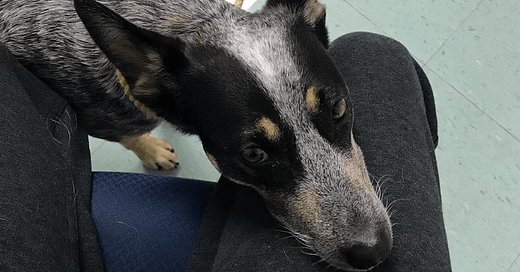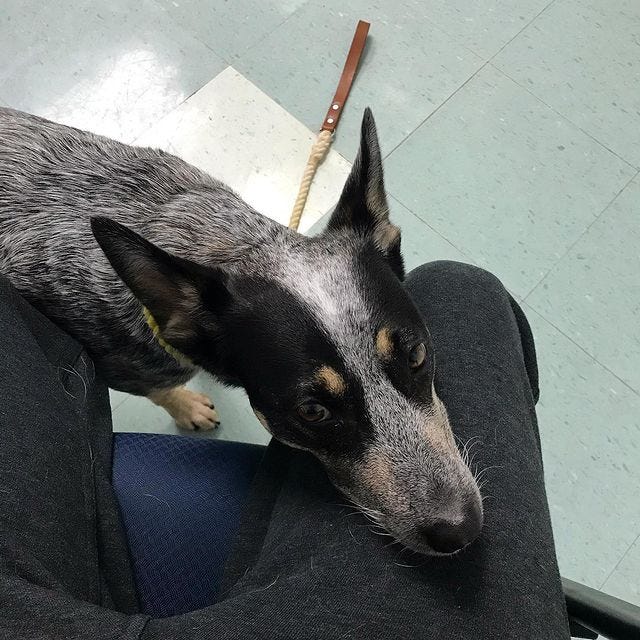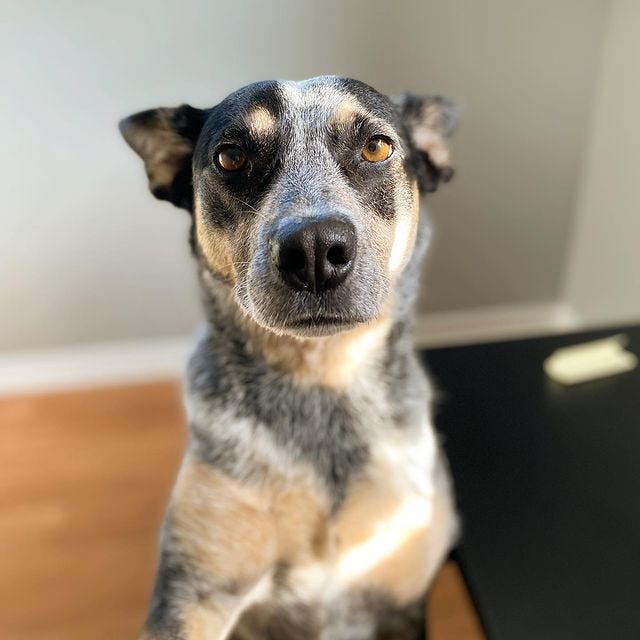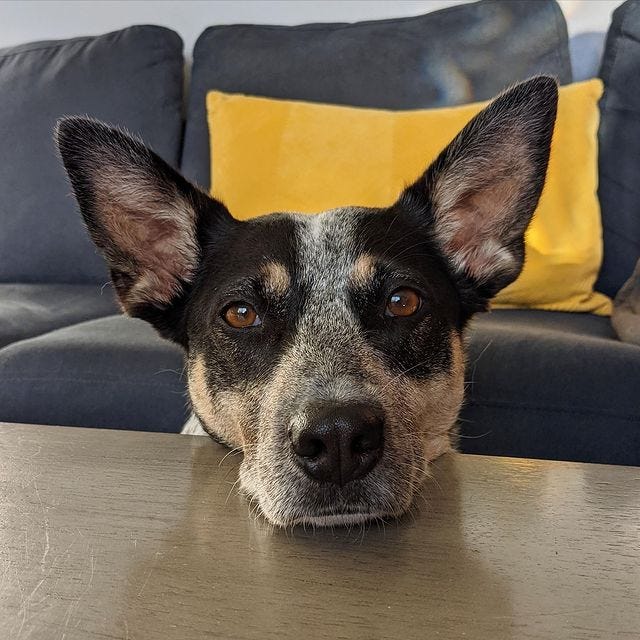First published in June 2022 when we made the decision to put Scout on a long-term anticonvulsant medication. Last updated in July 2024 with notes on how we're all doing now.
In December 2020, our blue heeler Scout had her first grand mal seizure.
It caught me completely off guard on an otherwise normal morning. I was home alone with no idea what was happening—I truly thought she might be dying. I'm still not sure how I made it out to the car with her or drove us safely to the vet.
Thanks to a great team of doctors, we came out of that initial episode relatively unscathed: shaken but equipped with knowledge. When Scout had her second seizure eleven months later in November 2021, it was easier to handle.
Then she had another episode the following February. And again in April. And May. That made five total, each seizure closer than the last, all about the same length, and still with no discernible triggers. It was an emotional, stressful, and sometimes bitter journey to get to the point where we put her on a daily anticonvulsant in June 2022—she's since had four breakthrough seizures that we've noticed—but we're moving forward together.
Here's a deep dive into our personal experience with canine idiopathic epilepsy.
* The same way I am not a professional dog trainer, I am also not a vet. I’m happy to share our life—but if you have specific concerns about your own companion or are thinking of changing up their epilepsy treatment, I encourage you to talk directly with their doctors and techs. Make those decisions as a team!
Scout's seizure summary
As of May 2022, we'd seen Scout have five seizures.
Her seizures were getting closer together. There were eleven months between the first two, then three, then two, then one.
Scout's episodes are mostly tonic. She appears paralyzed with glazed eyes but doesn't experience many rhythmic muscle jerks.
She typically doesn't have noticeable pre- or post-ictal symptoms. Her seizures happen out of nowhere and she recovers quickly (she often asks to play shortly afterward).
There is no pattern to her episodes. They've happened at different times of day, in a range of locations, and after varying activities.
We've checked all the products we use in our home and on our lawn.
She used to be on an oral tick preventative (Simparica) but we switched to topical (K9 Advantix II) after her second seizure. She's continued to have them since the change.
We decided to put her on a long-term anticonvulsant after her fifth seizure.
Since June 2022, we've noticed four breakthrough seizures on her medication. (We are so lucky this number is low!)
What on earth is happening happening to my dog?
I was frantic when Scout had her first seizure. We were lying on the floor together during a break between work meetings. She burrowed her head into my chest like usual—then suddenly she collapsed. Her hind legs didn't seem to be working. The wide, glazed look in her eyes told me this wasn't her typical clumsiness.
I called our vet as she froze on the carpet, all of her muscles tightening. They told me to get her there as quickly as we could, so I grabbed our slip lead by the door, hoisted her in my arms, and got to our car. Most of it's a blur, but I remember that she had control of her body again by the time we were pulling out of our apartment complex's parking lot.
Once I calmed down a little from the overwhelming feeling of "oh my gosh you're dying you can't die" I was able to realize the experience might have been a seizure. My description, along with a short video I took (and almost forgot about—I didn't remember to show it to our vet until several minutes into our emergency appointment, if that tells you how foggy my brain was) helped the doctors confirm that was the case.
Tests we've run to try to determine seizure cause
Once we knew it was a seizure, we tried to figure out what caused it.
Had she eaten something toxic? No—she was never outside unattended, and that morning's walk was totally standard. Did her blood work show anything unusual? No—her full panel was normal. Urinalysis abnormalities? Also no. Any recent changes in environment? No. Injuries? No. For every possibility, the answer was no. We couldn't find a single lead.
Our vet sent us on our way with steps to follow if she had another one. Turns out it's not that uncommon for a dog to have a lone seizure. If the physical exam turns out okay, there's no need for immediate concern.
For almost a year I thought we'd be the lucky ones—the ones whose dogs have a single episode, one time, just a fluke, never to return again—but then Scout had her second seizure eleven months later. We followed our vet's advice (timed it, called them right away) and ran more tests.
Again, everything came back clear.
Idiopathic epilepsy
At this point, our veterinary team loosely diagnosed Scout with "idiopathic" epilepsy, which literally means "arising spontaneously or from an obscure or unknown cause". I say loosely because idiopathic epilepsy is a diagnosis of exclusion—basically, it's the answer if no test abnormalities or environmental triggers are found. While we've run labs, spoken with a neurologist, and feel confident in our plan moving forward, it's worth noting there's always the chance we're missing some underlying cause.
I have mixed feelings about this diangosis.
Part of me wishes Scout's seizures weren’t idiopathic. If only there was some easy quick fix!
At the same time, I’m thankful she's otherwise healthy. Her epilepsy doesn't seem to indicate a larger problem.
It's nerve wracking not knowing if or when or where our heeler might have another seizure. But I remind myself I'd rather have that uncertainty over a more crushing prognosis.
Alternative explanations we've considered
While we've come to terms with Scout's idiopathic epilepsy diagnosis, we've also considered other potential causes along the way. A few things we've looked into:
Physical spine, back, or neck issues. In the summer of 2021 we had full hip X rays done for Scout to assess her strange gait (she always walks in a pace, also called a lateral gait, with the front and back legs on each side of her body moving together). Everything came back okay.
Environmental changes or diet. We've examined every product we use in our house, paid close attention to what she sniffs on walks, and carefully logged what happened before each seizure. We're still unable to find any pattern.
Hypothyroidism. All of Scout's blood work has continued to be normal.
Our seizure treatment plan
Here's how we're treating Scout's idiopathic epilepsy.
Keep intranasal midazolam on hand
Since Scout's second seizure, we've kept a vet-prescribed intranasal therapy called midazolam on hand in case of emergency. This sedative will interrupt an epileptic episode and prevent seizure clusters, ensuring that Scout's life isn't threatened by brain damage or an increase in body temperature.
Midazolam will also make our dog extremely lethargic and "out of it" afterwards. We don't administer it unless needed. (Thankfully, Scout's longest seizure so far was about four minutes and thirty seconds—she recovered on her own.)
We have this medicine in small syringes that need to be kept between 65 and 80 degrees fahrenheit. When we lived in our house, we brought it with us in a treat pouch, pocket, or backpack on most outings and stored it in the car glove compartment on road trips. Now that we live full time in our converted van, it's easier to keep on hand. Our house is mobile! We can access our belongings at pretty much all times.
Err on the side of caution with flea and tick preventatives
We also switched Scout off of an oral flea and tick preventative after her second seizure. (She's stayed on oral heart worm.)
Our vet doesn’t think it was a direct cause of her seizures for two main reasons:
Scout was on the same brand and dose for nearly two years without any issues
She continued to have increasingly worse episodes since moving to K9 Advantix II from Simparica
But there is evidence that oral preventatives can trigger epileptic activity in dogs who are already prone to it. We’re happy to play it as safe as we can! Scout gets a little itchy for the first day or two after we apply her topical preventative, but it's been easy to manage so far.
Don't jump to drastic lifestyle changes
Scout's seizures are thankfully not triggered by certain activities. Beyond keeping her medicine with us and being prepared to stay calm, we haven't had to stop playing and adventuring and having fun together. (It is not lost on me how fortunate we are.)
We do consider a few things more deeply than we did before she was diagnosed with epilepsy, though:
If we're going on a walk or hike, will we be able to carry her back if needed? (She might not be able to walk if we have to give her midazolam.) We opt for shorter treks now just in case.
When traveling out of town, we look up the nearest emergency vets in advance.
We keep copies of her medical records saved on our phones so we always have them.
We either need to be home at the right time to give her seizure medication twice each day or plan ahead to bring it with us on an outing. More on meds in the next section...
Give an anticonvulsant twice daily
After Scout's fifth seizure, just five weeks after her previous episode, our veterinarian prescribed her with phenobarbital. She takes 32.4mg twice a day.
Why we avoided seizure medication at first
We weren't in a hurry to put Scout on a long-term anticonvulsant.
To be clear, we are not "anti med" in any way. (I hope that's obvious from the fact she's on one now.) Rather, prior to her fifth seizure, Scout was around the cut off where our vet said she could go either direction with long-term therapy. We decided to hold off based on cost-benefit analyses and risk assessments we made in partnership with our clinic, considering things like:
Side effects of anticonvulsant options: They work by suppressing neural activity and can cause lethargy, lack of coordination, and more.
Scout's previous sensitivity to medications: She's taken a long time to come out of anesthesia or sedation ever since we adopted her.
Her quick recovery from each seizure: Without pre- or post-ictal symptoms, her seizures did not drastically affect her day.
The lifelong nature of the meds if we put her on them: The odds of being able to stop anticonvulsant treatment are low, making this a permanent decision.
The necessary blood work she'd need at regular intervals: Medication effects need to be monitored, which means added vet trips with extra tests and associated stress (plus financial commitment).
How spread out her episodes were: Scout initially went multiple months between each seizure.
Why we've decided to put our dog on long-term meds now
Unfortunately, Scout's fifth seizure highlighted a concerning pattern. It happened only five weeks after her previous episode. Every seizure was getting closer together and staying about the same length (just below the amount of time where we'd need to administer midazolam).
Our cattle dog also experienced pre-ictal symptoms (sometimes called aura) for the first time and took longer to recover. While she still bounced back within a half hour, our vet team felt all signs indicated her seizures would only get worse.
We still wrestled with the decision to put Scout on long-term medication. It felt like there were no "ideal" options:
We hated the potential side effects of available anticonvulsants.
We also hated the idea of her episodes getting more serious.
There's a lot vets still don't know about idiopathic epilepsy.
Every dog can respond to treatment differently.
We could opt to run additional tests, but they'd be financially expensive and physically invasive. There was also a good chance they wouldn't find anything to change our treatment plan.
That said, I abhorred the idea of not pursuing every single last potential lead, no matter how tiny it was.
It was tough to feel like we had adequate, accurate information to make a confident choice. Sean and I both sat down with our vet in person to ask a slew of questions and think about further referrals to neurology. After that, we spent multiple days talking it through.
We ultimately decided to fill our vet's prescription for phenobarbital.
I feel so lucky to have a veterinary team we trust. They provided clear reasoning, addressed our concerns, and gave us the space we needed to settle on a treatment plan. Our primary vet expressed her faith in me as an owner (something I still struggle with at times) and was the first to hand me tissues when I caved and shared how worried I was that this was somehow my fault.
I'm not sure how things might change moving forward... but I do know Scout has an awesome group of people on her side.
Life with epilepsy isn't ideal—but it's doable
Accepting that my beloved dog is epileptic has been a whirlwind of emotions.
At first, when Scout's seizures were few and far between, I was scared but able to keep perspective. Then, when we were faced with how much worse they were getting, I felt angry and overwhelmed and like it was just so unfair. Why us? I know so many other rescue dogs from similarly uncertain pasts who have never developed medical issues. I know so many other owners who pay less attention to their pets' health. If I'm honest, I spent a few days struggling with bitterness.
And the comparisons went both ways. Every time I felt angry Scout was going through this, a voice in my head reminded me of all the dogs out there going through much worse. At least idiopathic epilepsy isn't directly life threatening. It's not a death sentence. It's treatable! How dare I wallow in self pity when we're actually so lucky.
Ultimately, it's been messy. I've been messy.
But I've eventually come to terms with Scout's condition and what it means for our life together. I've accepted it's okay to feel sad and even a little angry. There's nothing wrong with admitting this sucks. At the same time, it's also important to stay productive—pining and whining won't change the facts at hand.
Sure, life with an epileptic dog isn't ideal. Sometimes she stretches in a weird way and I frantically become convinced she's having a seizure. I'm always double checking if we have her emergency meds. I frankly felt a bit terrified of how her long-term anticonvulsant might change her personality.
But life with an epileptic dog is also completely doable. We can make small changes, take reasonable steps, and ultimately still have a blast in this great big world.
I've got you, cattle dog. Whatever comes next.
July 2024 update
Hello hello again—it's been two full years since Scout started her anticonvulsant! Revisiting this article was an emotional whirlwind. All the memories flooded back. Confusion, worry, sadness.
Thankfully, Scout's epilepsy is in many ways a smaller part of our lives than ever before now. Since putting her on medication, we've only noticed four (yes, four—that is such a low number based on efficacy estimates) breakthrough seizures. She initially struggled with side effects (in particular, increased hunger) but aside from increased appetite she's essentially the same dog she was before.
Here's where things sit nowadays.
It's possible—I'd say even likely—that we've missed some breakthrough seizures. We are unable to be with Scout 24/7. And because she doesn't convulse much during her episodes, one could happen when she's in bed without us immediately noticing.
We also had a scare this spring where Scout had two seizures within a week of each other. I was so worried something was wrong. Maybe we needed to up her anticonvulsant dose? But months later it seems to have been a fluke.
We're in high spirits about her epilepsy as time's gone on. I feel so lucky life has been able to continue relatively unchanged. Meds were the right decision for us.
We do still make sure to have her emergency meds on hand. All the extra considerations listed above still apply!
We send so much love to anyone else dealing with epilepsy with their own dogs 💛













Our five year old blue heeler, Bandit, started having seizures back in November of 2022 after a routine vaccination. Your story sounds very similar to ours. Tests all came back normal and we were told to put her on medication. After learning about the side effects of the medication, I searched for a more holistic approach and found a vet who said we could treat with diet, acupuncture, and natural supplements. I also did my own research and found https://www.allergicpet.com/. The Nuroplex 2 oz Homeopathic Spray has been a miracle! It stopped her seizures when she had them and we have been giving her 3 sprays twice a day before meals as a preventative. I think her last episode was spring of 2024. Apparently when most folks have allergies, that's also the time that seizures are more likely. Since we've been using the spray and giving her real food - turkey, barley, pumpkin, spinach, mushrooms - she's lost 25 lbs and is in amazing health. I know how scary this experience can be and I'm grateful we found a plan that's worked amazingly well for us. Wishing the very best for you guys and Scout!